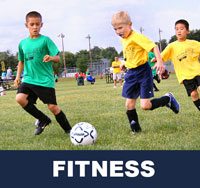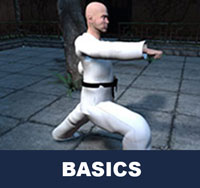Taekwondo 태권도Taekwondo Preschool
Promotion from one geup to the next can proceed rapidly in some schools, since schools often allow geup promotions every two, three, or four months. Students of geup rank learn the most basic techniques first, and then move on to more advanced techniques as they approach first dan. Many of the older and more traditional schools often take longer to allow students to test for higher ranks than newer, more contemporary schools, as they may not have the required testing intervals. View Taekwondo belt levels »

Physical Fitness
Physical fitness is generally achieved through correct nutrition, exercise, hygiene and rest.
Physical fitness is a general state of health and well-being or specifically the ability to perform aspects of sports or occupations. It is a set of attributes or characteristics that people have or achieve that relates to the ability to perform physical activity.
Before the industrial revolution, fitness was the capacity to carry out the day’s activities without undue fatigue. However with automation and changes in lifestyles physical fitness is now considered a measure of the body’s ability to function efficiently and effectively in work and leisure activities, to be healthy, to resist hypokinetic diseases, and to meet emergency situations
A comprehensive fitness program tailored to an individual typically focuses on one or more specific skills, and on age or health-related needs such as bone health. Many sources also cite mental, social and emotional health as an important part of overall fitness. This is often presented in textbooks as a triangle made up of three points, which represent physical, emotional, and mental fitness. Physical fitness can also prevent or treat many chronic health conditions brought on by unhealthy lifestyle or aging. Working out can also help people sleep better. To stay healthy it is important to engage in physical activity.

Diet is an important component to overall health that works best in combination with exercise. A balanced diet and exercising regularly are important for maintaining good health. Obesity is defined as body mass index, a measure of weight in relationship to height (Blair, 1993). With obesity on the rise, the U.S. has implemented more exercise and diet plans. There are millions of programs, websites, television shows, magazines, and movies regarding health and fitness. Recently, the trends of diets and lifestyle habits have become more and more encouraged. Understanding the importance of the health benefits resulted from diet and exercise will help decrease the amount of obesity in this country. Physical activity and exercise is defined in terms of type, intensity, duration and frequency (Blair, 1993).
Training
In order for physical fitness to benefit the health of an individual, an unknown response in the person called a stimulus will be triggered by the exertion. When exercise is performed with the correct amount of intensity, duration and frequency, a significant amount of improvement can occur. The person will overall feel better but the physical effects on the human body take weeks, months, or even years to be noticed or fully developed. For training purposes, exercise must provide a stress or demand on either a function or tissue. To continue improvements, this demand must eventually increase little over an extended period of time. This sort of exercise training has three basic principles: overload, specificity, and progression. These principles are related to health but also enhancement of physical working capacity (Blair, 1993).
Cardiovascular Training
Cardiorespiratory training involves movement that increases the heart rate to improve the body's oxygen consumption. This form of exercise is an important part of all training regiments ranging from professional athletes to the everyday person. Also, it helps increase stamina. Examples below:
- Jogging – Running at a steady and gentle pace. This form of exercise is great for maintaining weight.
- Elliptical Training – This is a stationary exercise machine used to perform walking, or running without causing excessive stress on the joints. This form of exercise is perfect for people with achy hips, knees and ankles.
- Walking – Moving at a fairly regular pace for a short, medium or long distance. Many walkers enjoy getting their workouts in at their local mall.
- Swimming – Using your arms and legs to keep yourself afloat and moving either forwards or backwards. This is a good full body exercise for those who are looking to strengthen their core while improving cardiovascular endurance.
- Biking – Riding a bicycle typically involves longer distances than walking or jogging. This is another low stress exercise on the joints and is great for improving leg strength.
Physical Fitness has proven to result in positive effects the body's blood pressure. This is because staying active and exercising regularly builds up a stronger heart. The heart is the main organ in charge of systolic blood pressure and diastolic blood pressure. Engaging in a physical activity will create a rise in blood pressure, once the activity is stopped, however, the individual’s blood pressure will return to normal. The more physical activity that one engages in, the easier this process becomes, resulting in a more ‘fit’ individual. Through regular physical fitness, the heart does not have to work as hard to create a rise in blood pressure, which lowers the force on the arteries, and lowers the over all blood pressure.

Training Safety Precautions
Usually before the taekwondo class starts, the master ( 사범님 sabeomnim ) instructs the students to jog around the dojang to warmup. Depending on the size of the dojang, several laps are done. Risk of injury can be reduced by completing an effective warm-up consisting of a heart raiser to get your pulse up, followed by sport specific dynamic stretches (stretches whilst moving).
* Please see a certified Master Instructor ( 사범님 sabeomnim ) for training. Proper guidance and instructions are needed to ensure safe training.

Related Articles
Physical fitness is a general state of health and well-being or specifically the ability to perform aspects of sports or occupations. It is a set of attributes or characteristics that people have or achieve that relates to the ability to perform physical activity. View Physical Fitness »
- Stretch - Form of physical exercise in which a specific muscle or tendon (or muscle group) is deliberately flexed or stretched in order to improve the muscle's felt elasticity and achieve comfortable muscle tone. The result is a feeling of increased muscle control, flexibility and range of motion.
- Flexibility - Refers to the absolute range of movement in a joint or series of joints, and length in muscles that cross the joints. Flexibility in some joints can be increased to a certain degree by exercise, with stretching a common exercise component to maintain or improve flexibility.
- Endurance - Ability of a practitioner to exert itself and remain active for a long period of time, as well as its ability to resist, withstand, recover from, and have immunity to trauma, wounds, or fatigue.
- Balance - Ability to maintain the line of gravity (vertical line from centre of mass) of a body within the base of support with minimal postural sway. Sway is the horizontal movement of the centre of gravity even when a person is standing still.
- Agility - Or nimbleness is the ability to change the body's position efficiently, and requires the integration of isolated movement skills using a combination of balance, coordination, speed, reflexes, strength, and endurance.

Taekwondo Basics
Here is where you can learn more about Taekwondo 태권도. Knowing the fundamental basics is very important for your learning path as you build your skills and knowledge. There are certain rules that need to be followed to show respect to the master ( 사범님 sabeomnim ), the instructors ( 교사님 gyosannim ), other practitioners and to the martial arts. They vary between schools but many have similar rules and guidelines. For more information View Taekwondo Basics »
Please follow the guidance of a certified Master Instructor or trainer when doing sports related activities. The article provided on this page is information that is widely available on Wikipedia article "Physical Training". Risk of injury can be reduced by completing an effective warm up consisting of a heart raiser to get your pulse up, followed by sport specific dynamic stretches (stretches whilst moving).
There are five tenets defined in the International Taekwondo Federation (ITF) and several more in World Taekwondo (WT).
Integrity ( 염치 yeom-chi ): "Although it may be similar, this form of integrity takes on a more wider role then defined in the common dictionary. In taekwondo, integrity means not only to determine what is right or wrong but also having the conscience to feel guilt if one has done wrong and to have the integrity stand up for what is right." View Taekwondo Tenets »
RESOURCES
This article uses material from the Wikipedia article "Physical Training", which is released under the Creative Commons Attribution-Share-Alike License 3.0.



















